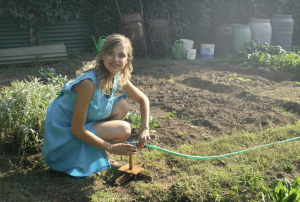A Sustainable Yard: 6 Ways to Create a Paradise
A sustainable yard can be one of the most valuable aspects of your home, and not just from a financial perspective. Having a yard means you have an incredible resource to improve the quality of your family’s life. With a little effort and investment, you can develop that space into a personal oasis. However, it’s important to also consider your environmental responsibilities. The world is facing a serious climate crisis and everyone has a part to play in arranging improvements. As such, the choices you make for your yard need to minimize your negative impact. But you can go further. You can also seek options that will actively contribute to the well-being of the planet. We’re going to explore 6 ways you can create a sustainable backyard paradise.

Image Source: Pexels
Add Native Plants
Plants can make a plain backyard into a truly beautiful space to spend time in. However, it’s important to make sure you take a considered approach to what you put in the ground. While exotic plants can look beautiful, they’re not the most sustainable option. As they come from different climates, they often consume much more water or require additional nutrients in the soil. A more eco-conscious approach is to focus on native plants.
You’ll also find filling your yard with native plants is beneficial for the local wildlife and ecosystem. Choose flowering plants from your region to attract pollinators like bees and butterflies. These provide nectar to feed and support vital contributors to the well-being of our environment. Some native hedges and bushes can also offer habitats to birds and other
animals.
Reduce Turf Grass for a Sustainable Yard
Turf grass has long been a standard feature of suburban yards. However, it doesn’t have much of a place in a backyard paradise. This isn’t just because it’s a relatively plain and uninteresting feature. It is also actively bad for the environment. Firstly, it doesn’t provide any habitat or food sources for pollinators. You’ll also utilize significant non-renewable electricity or gas resources in mowing it regularly.
As such, it’s wise to reduce the amount of turf grass in your backyard. There are certainly more sustainable alternatives. You can use the soil in the area to grow a vegetable garden. This minimizes your reliance on store-bought foods that put pressure on the environment through transport and production. You might also consider allowing portions of grass to grow wild and allowing weeds to grow in the area. This encourages habitation by native pollinators.
Use Smart Irrigation for a Sustainable Yard
Having a backyard filled with plants and flowers can certainly benefit the local ecosystem. Not to mention it creates a space of natural beauty for your family to relax in. However, they’ll need regular irrigation to thrive. This is especially vital in the summer months. When pursued recklessly, you can put pressure on the local reservoir systems and contribute to shortages in the area. It is, therefore, responsible to consider adopting a smart irrigation system. This technology monitors data on local weather patterns and adjusts irrigation schedules to match. There are also systems that utilize sensors to measure the level of moisture in the soil. In both cases, the tools are designed to ensure your backyard only receives the amount of water necessary for nutrition. There’s very little scope for wastage.
Install Solar Panels for a Sustainable Yard
Installing solar panels is among the most impactful eco-friendly updates you can make to your home. This not only helps to reduce the emissions caused by your consumption of fossil fuel electricity sources. It can also minimize your utility bills. Many people are put off by the idea of having to arrange for large panels to be installed on their roofs, but this isn’t necessary. You can install solar panels in your backyard, too. If you think about it, your yard provides open space that sees a significant amount of daylight.Ground mounted solar panels can take advantage of this space without being too invasive. You can install an array on a metal frame or affix raised panels to a pole. If you’re concerned about the aesthetic effect, you can trail climbing plants around the supporting structures.
Harvest Rainwater
Using smart irrigation technology isn’t the only way to reduce pressure on your local water system. Harvesting rainwater is a natural way to collect sufficient volumes of water to make sure your plants get the resources they need. It also means you can store water for use during the dry periods of the year, avoiding the risk of exacerbating droughts. Not to mention it tends to reduce your costs, too. You can purchase effective rain harvesting systems. However, it is possible to make your own using a barrel and some piping. In either case, you’ll be attaching it to your guttering system at the side of your home to collect run-off from your roof. Unfortunately, in some states it is illegal to harvest rainwater, so you’ll need to be aware of the regulations in your area.
Upcycle Patio Furniture
Getting patio furniture can be the perfect finishing touch to your backyard paradise. However, it’s important to avoid simply buying new items. Even if you’re utilizing items made from recycled plastics, the manufacturing process can still produce waste and emissions. Your best approach is to upcycle older patio furniture. Head to your local thrift or used furniture store. Find items that you can refresh with a coat of waterproof stain. If you need to update the seat cushions, consider using natural materials like hemp or cotton. Not only is this more eco-friendly, it also adds a more personal touch to your yard.
Conclusion
Your backyard should be a positive feature for both your family and the local ecosystem. Make considered decisions about plants and turf that support local pollinators. Utilize technology such as smart irrigation systems and solar panels to reduce pressure on the environment. If you need to add furniture, opt for updating used items rather than buying new ones. Like so many sustainable activities, these are relatively simple steps. It just takes a little extra planning for you to make a positive difference.
Sources:
https://www.gardeningknowhow.com/garden-how-to/watering/what-is-smart-irrigation.htm
https://www.raleighrealtyhomes.com/blog/eco-friendly-home-updates.html
https://worldpopulationreview.com/state-rankings/states-where-it-is-illegal-to-collect-rainwater
https://worldpopulationreview.com/state-rankings/states-where-it-is-illegal-to-collect-rainwater
